
Francisco José de Goya y Lucientes was a Spanish romantic painter and printmaker. He is considered the most important Spanish artist of the late 18th and early 19th centuries. His paintings, drawings, and engravings reflected contemporary historical upheavals and influenced important 19th- and 20th-century painters. Goya is often referred to as the last of the Old Masters and the first of the moderns.

Maurice Quentin de La Tour was a French painter who worked primarily with pastels in the Rococo style. Among his most famous subjects were Voltaire, Rousseau, Louis XV and the Madame de Pompadour.

Adélaïde Labille-Guiard, also known as Adélaïde Labille-Guiard des Vertus, was a French miniaturist and portrait painter. She was an advocate for women to receive the same opportunities as men to become great painters. Labille-Guiard was one of the first women to become a member of the Royal Academy, and was the first female artist to receive permission to set up a studio for her students at the Louvre.

The Naked Maja or The Nude Maja is an oil-on-canvas painting made around 1797–1800 by the Spanish artist Francisco de Goya, and is now in the Museo del Prado in Madrid. It portrays a nude woman reclining on a bed of pillows, and was probably commissioned by Manuel de Godoy, to hang in his private collection in a separate cabinet reserved for nude paintings. Goya created a pendant of the same woman identically posed, but clothed, known today as La maja vestida, also in the Prado, and usually hung next to La maja desnuda. The subject is identified as a maja or fashionable lower-class Madrid woman, based on her costume in La maja vestida.

The Savonnerie manufactory was the most prestigious European manufactory of knotted-pile carpets, enjoying its greatest period c. 1650–1685; the cachet of its name is casually applied to many knotted-pile carpets made at other centers. The manufactory had its immediate origins in a carpet manufactory established in a former soap factory on the Quai de Chaillot downstream of Paris in 1615 by Pierre DuPont, who was returning from the Levant.
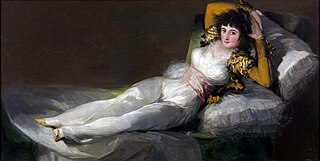
La maja vestida is an oil painting on canvas created between 1800 and 1807 by the Spanish Romantic painter and printmaker Francisco Goya. It is a clothed version of the earlier La maja desnuda, which was created between 1795 and 1800. The identity of the model and that of the commissioner have not been confirmed. However, art historians and scholars have suggested she is María Cayetana de Silva or Godoy's mistress Pepita Tudó.
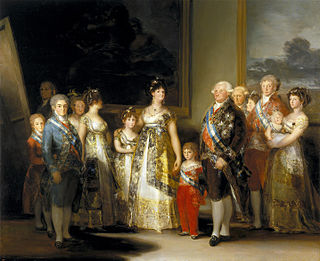
Charles IV of Spain and His Family is an oil-on-canvas group portrait painting by the Spanish artist Francisco Goya. He began work on the painting in 1800, shortly after he became First Chamber Painter to the royal family, and completed it in the summer of 1801.

Portrait of Madame Récamier is an 1800 portrait of the Parisian socialite Juliette Récamier by Jacques-Louis David showing her in the height of Neoclassical fashion, reclining on a Directoire style sofa in a simple Empire line dress with almost bare arms, and short hair "à la Titus." The work is unfinished.
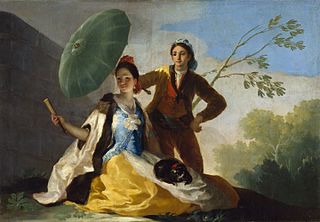
The Parasol is one of a cartoon series of oil on linen paintings made by the painter Francisco Goya. This series of paintings was specifically made in order to be transformed into tapestries that would be hung on the walls of the Royal Palace of El Pardo in Madrid, Spain. The tapestries showed serene events in everyday life, which made them a nice addition to the dining room of Prince and Princess of Asturias—the future King Charles IV and Maria Luisa of Parma. The queen called on Goya because she wanted to decorate the dining room with cheerful scenes; The Parasol and the other tapestry paintings were Goya's response to this request. The painting is currently located in the Museo del Prado in Madrid as is another in the series, Blind man's bluff.

The Goya Museum is an art museum located in Castres, France. The museum was originally established in 1840 and was named after the Spanish painter Francisco Goya since it specialised in hispanic art from 1947.

La Leocadia or The Seductress are names given to a mural by the Spanish artist Francisco Goya, completed sometime between 1819–1823, as one of his series of 14 Black Paintings. It shows a Leocadia Weiss, his maid and likely his lover. She is dressed in a dark, almost funeral maja dress and leans against what is either a mantelpiece or burial mound as she looks outward at the viewer with a sorrowful expression.
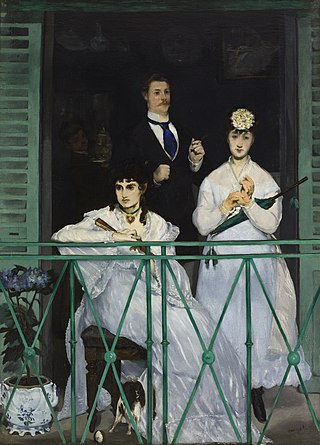
The Balcony is an 1868–69 oil painting by the French painter Édouard Manet. It depicts four figures on a balcony, one of whom is sitting: the painter Berthe Morisot, who married Manet's brother Eugène in 1874. In the centre is the painter Jean Baptiste Antoine Guillemet. On the right is Fanny Claus, a violinist. The fourth figure, partially obscured in the interior's background, is possibly Léon Leenhoff, Manet's son.
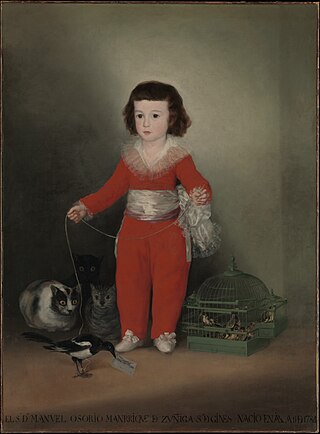
Manuel Osorio Manrique de Zúñiga is a large full-length portrait in oil painted in 1787–88 by the Spanish artist Francisco Goya. It depicts a boy three or four years of age, standing in red clothes, with birds and cats. It is also known as Goya's "Red Boy". It was described by art historian Claus Virch in 1967 as "one of the most appealing and successful portraits of children ever painted, and also one of the most famous". The painting has been held by the Metropolitan Museum of Art, in New York, since 1949.

The Portrait of the Marchioness of Santa Cruz or Portrait of the Marquise of Santa Cruz is an 1805 portrait by the Spanish artist Francisco Goya, a family friend of the subject. It has in the Museo del Prado, in Madrid, since 1986, when it was bought from its previous owner for over US$6 million.

The Duchess of Alba and "la Beata" is a oil-on-canvas painting by the Spanish artist Francisco Goya, from 1795.

The White Duchess is a life sized oil-on-canvas painting by the Spanish artist Francisco Goya, completed in 1795. It portrays María Cayetana de Silva, 13th Duchess of Alba. It is in the collection of the House of Alba, in the Liria Palace, Madrid. It is one of a number of portraits Goya painted of the duchess around this time, and is usually compared alongside the similarly sized but tonally very different The Black Duchess, which was painted two years later, just after her husband, José Álvarez de Toledo died aged 39. The duke and duchess were highly placed, cultivated and well-regarded members of the 1790s Spanish Court.

Portrait of Ferdinand Guillemardet is an oil painting by Francisco Goya, from 1798-1799. It depicts Ferdinand Guillemardet (1765-1809), the French ambassador to Spain between 1798 and 1800. It is held in the Louvre, in Paris.

María Rita de Barrenechea y Morante de la Madrid, Countess of Carpio, Marchioness of la Solana was a Spanish writer and playwright of the Age of Enlightenment. She is considered the first Basque playwright and one of the first playwrights in Spanish whose work was edited by a publisher. She was a member of the first group of women of the Board of Ladies of the Matritense Economic Society.

Project for the Transformation of the Grande Galerie du Louvre is an oil-on-canvas painting by the French painter Hubert Robert, made in 1796. It is held at the Louvre, in Paris. The Louvre acquired the painting in 1975; it is exhibited in the Sully wing, of the French paintings.
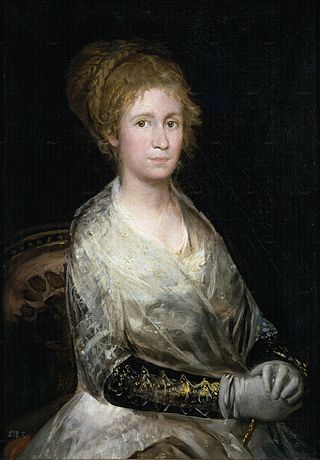
Josefa Bayeu or Leocadia Zorrilla is an oil painting by the Spanish painter Francisco Goya. It is currently housed in the Museo del Prado.




















